Court Ruling on Patent Claim Interpretation
Date: 14 November 2024
【Volume 145】
In light of the specificity of mechanical cases, it often lacks precise or commonly known terms to define elements, configuration, and states thereof. This frequently leads to disputes over the interpretation of descriptions in claim in mechanical patents. Recently, in the judgment for the infringement litigation Everlight Electronics Co., Ltd. v. Jan Cheng Lighting Co., Ltd. involving a light emitting device (Taiwan Intellectual Property and Commercial Court 2023 Min Zhuan Su Zi No. 18 Judgment), the court reaffirmed two critical principles in claim interpretation: first, intrinsic evidence has priority over extrinsic evidence; and second, improperly importing a limitation from the specification into the claims is prohibited, which is noteworthy.
Case Fact
Everlight Electronics Co., Ltd. (plaintiff), a key company in the LED industry, is the patentee of Taiwan Invention Patents TWI553264B, TWI644055B, and TWI665406B (referred to as the ‘264, ‘055, and ‘406 patents, respectively). The plaintiff discovered that the Class A products (with concave electrode structures) and Class B products (with convex electrode structures), commissioned, imported, and sold by the defendant, Jan Cheng Lighting Co., Ltd., violated the literal scope of ‘264, ‘055, and ‘406 patents. The plaintiff filed a lawsuit with the court, asserting that the defendants, YUN CHENG LIGHTING CO., LTD., LEE CHENG LIGHTING CO., LTD., and Jan Cheng Lighting Co., Ltd., who jointly sold under the name of “Jan Cheng Group”, should be jointly liable for damages.
The defendants argued that the product photographs submitted by the plaintiff failed to demonstrate infringement and simultaneously raised a defense of patent invalidity. In the end, the court determined that ‘264, ‘055, and ‘406 patents lacked novelty and inventive step based on Exhibits 22 to 31 presented by the defendants, leading to the plaintiff's defeat. However, what is worth noted is that the court's primary focus in this ruling was on the interpretation of the claims.
Technical content of the case
‘264, ‘055, and ‘406 patents relate to lead frames for housing LED chips and the light-emitting devices derived from them.
Claim 1 of ‘264 patent:
A carrier, comprising: at least one electrode portion, each of the electrode portions comprising an electrode portion cross section; and a housing comprising a housing cross section and at least partially covering the at least one electrode portion,
wherein the housing cross section or the electrode portion cross section comprises at least one curved surface.
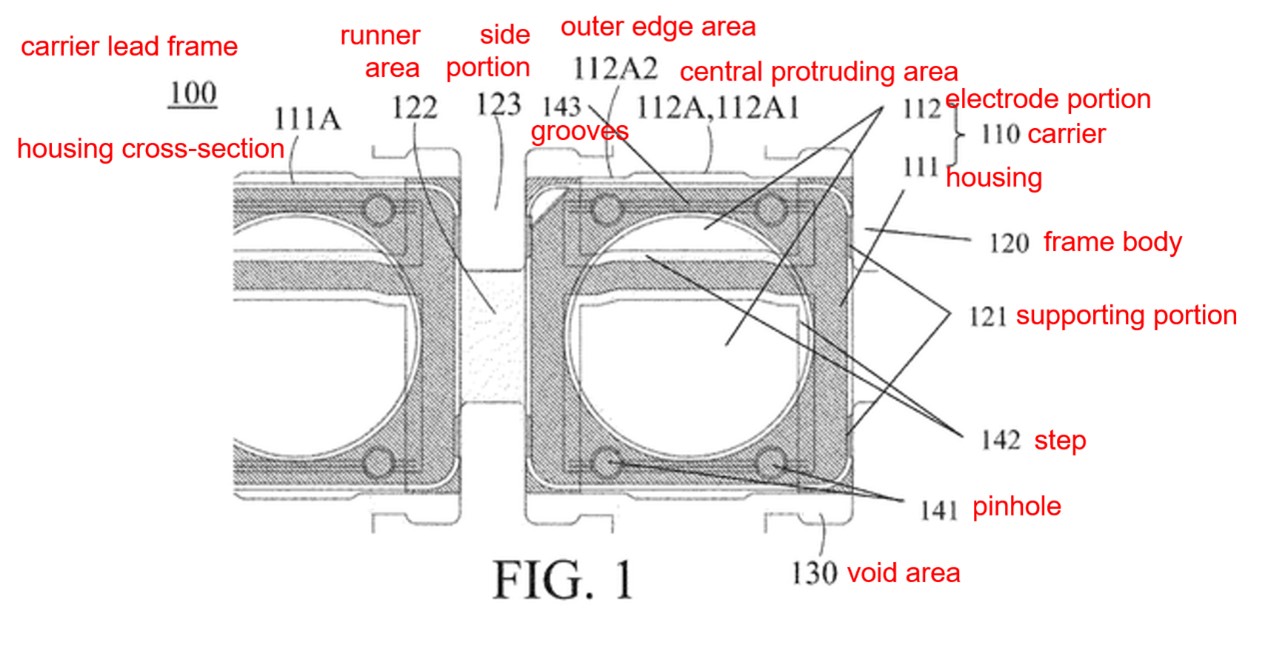
FIG. 2.1.1: partial schematic view of an embodiment of the carrier lead frame
Claim 1 of ‘055 patent:
A light-emitting device, comprising: a carrier; and a LED chip die-bonded in the carrier; wherein the carrier comprises: at least one electrode portion, having an electrode portion cross-section; and a housing, having a housing cross-section, said housing at least partially enclosing the electrode portion; wherein the housing cross-section and the electrode portion cross-section are non-level.
Claim 1 of ‘406 patent:
A light-emitting device, comprising: a carrier; and an LED chip die-bonded in the carrier; wherein the carrier comprises a housing and at least one electrode portion, said housing partially enclosing the at least one electrode portion, and said at least one electrode portion comprises a wing portion, exposed outside the housing, having a central area and at least one edge area, with the at least one edge area protruding from the central area; wherein the at least one electrode portion comprises an electrode portion cross-section, and the housing comprises at least one housing cross-section.
The main issue in this case lies in how the terms "electrode portion cross-section," "housing cross-section," "non-level," and "protruding" should be construed.
Opinion of the court
1. The interpretation of claims should be based on the scope of the claims, taking the specification and drawings into consideration, with priority given to the application of intrinsic evidence (referring to the decision in the Supreme Administrative Court 2014 Pan Zi No. 417 Judgment).
2. Interpretation of "housing cross-section" and "electrode portion cross-section" in the claims of the patents:
a. The plaintiff asserted that "housing cross-section" refers to the cut surface formed on the housing of the carrier by removing residual material during processing, and "electrode portion cross-section" refers to the cut surface formed on the electrode portion of the carrier by removing extension portion during processing. The defendants countered that "electrode portion cross-section" should be interpreted broadly as the cut surface "which is not limited to a cut surface formed on the surface of the electrode portion after removing the extension portion", and "housing cross-section" as the cut surface "which is not limited to a cut surface formed on the surface of the housing after removing the residual material".
b. The wording of the claims is not sufficient to clearly explain the terms "housing cross-section" and "electrode portion cross-section", and the related contents in specification, such as paragraph [0022] describing that "removing the extension portion forms at least one electrode portion cross-section on the electrode portion of the carrier, and removing residual material forms a housing cross-section on the housing of the carrier", and [0047] and FIG. 14, 15 and [0048] and FIG. 16, have related descriptions without further explanation. Therefore, next, the patent prosecution history should be checked. The response to Office Action submitted during prosecution describes that "specifically, the electrode portion cross-section and the housing cross-section in Claim 1 are cut surfaces which are defined by, for example, removing the extension portion during process (referring to paragraph [0022] of specification) and those cut surfaces are further defined as having curved surface", indicating that those terms in Claim 1 have been interpreted restrictively regarding the manner of setting during prosecution to distinguish the invention from prior art and support its inventive step. Thus, "housing cross-section" should be interpreted as "the cut surface formed on the housing of the carrier by removing residual material" and "electrode portion cross-section" should be interpreted as "the cut surface formed on the electrode portion of the carrier by removing extension portion".
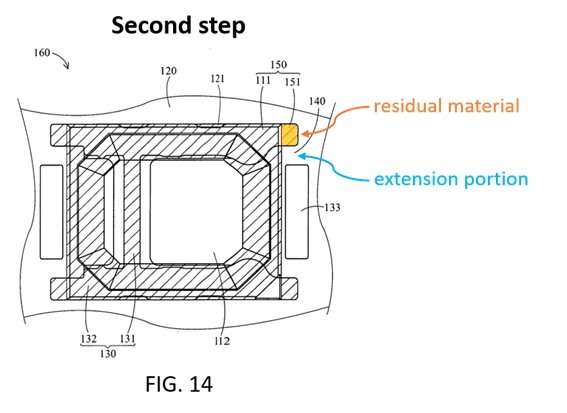
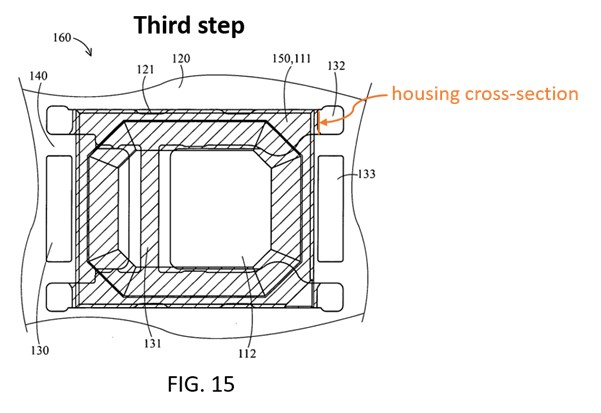
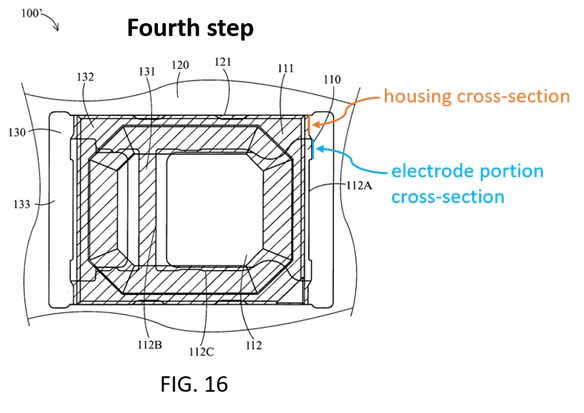
c. The defendants argued that performing removal steps on the same material in any order during process would all result in a "cut surface." However, paragraph [0022] of the specification clearly outlines the restrictions on the terms "housing cross-section" and "electrode portion cross-section." The defendants' interpretation on these terms is subjective and belongs to extrinsic evidence. When interpreting the terms "housing cross-section" and "electrode portion cross-section" based on evidences, priority should be given to the intrinsic evidence including the patent specification.
3. Interpretation of "non-level" in the claims of the patents:
a. The plaintiff asserted that "non-level" refers to a situation where the housing cross-section and the electrode portion (wing portion) are connected, and the electrode portion cross-section and housing cross-section are on the same plane of the carrier but do not form a flat surface. The defendants countered by stating that "the housing cross-section and the electrode portion cross-section being non-level" should be interpreted without being limited to that the housing cross-section and the electrode portion are connected and on the same plane of the carrier, and that the housing cross-section and the electrode portion cross-section do not result from the simultaneous removal of residual material and extension portion.
b. Upon review, paragraph [0022] of the patent specification states that when the electrode portion cross-section and the housing cross-section are on the same surface of the carrier, they can either be level (forming a flat surface) or non-level (not forming a flat surface). Furthermore, according to the examples in paragraphs [0023], [0042], [0051], as well as Figs. 1, 5, 12D, and 17D, "level" refers to that when the electrode portion cross-section and the housing cross-section are on the same surface of the carrier, they can form a flat surface, while "non-level" refers to that when the electrode portion cross-section and the housing cross-section are on the same surface of the carrier, they do not form a flat surface.
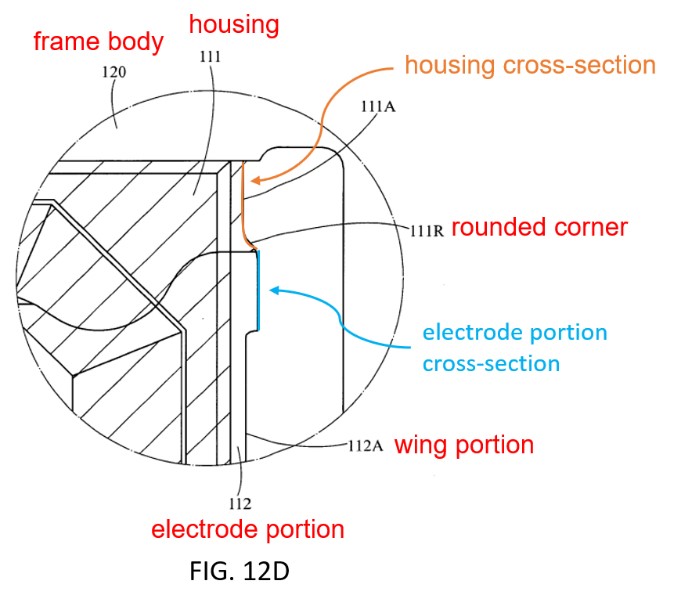

c. The defendants argued that the technical feature that "and the housing cross-section and the electrode portion cross-section are not formed by the simultaneous removal of residual material and extension portion" should be included to align with the technical problem and solution of the patent. However, this introduces content disclosed in the specification or drawings but not described in the claims into the claims. Such an argument clearly improperly imports a limitation from the specification into the claims, which is prohibited.
d. The plaintiff argued that "level" and "non-level" imply that the housing cross-section and the electrode portion (wing portion) must be "connected." However, according to paragraph [0022] of the patent specification, the interpretation of level or non-level is primarily based on whether the housing cross-section and electrode portion cross-section form a flat surface, and it is not limited to that they have to be "connected". Overinterpreting the claim wording in this way could improperly import a limitation from the specification into the claims, making the plaintiff's argument unfounded.
4. Interpretation of "protruding" in the claims of the patents:
a. The defendants argued that the positions of "central area," "edge area," and "housing cross-section" described in the claims of the patent are not defined, rendering the structure unclear, particularly with the phrase "protruding." They further argued that the claims should include the technical feature that "the housing cross-section and the electrode portion cross-section are not formed by the simultaneous removal of residual material and extension portion" to align with the purpose and means of the patent. Again, the defendants' interpretation introduced content from the specification into the claims which had already clearly defined the terms "central area," "edge area," and "housing cross-section," improperly narrowing the claims with limitation from the specification.
5. The plaintiff asserted that, in the invalidation case No. N03 of ‘264 patent, whether Exhibit 26 has a "housing cross-section" which is a cut surface formed on the housing of the carrier after the removal of residual material cannot be directly and unambiguously deduced from the disclosure in Exhibit 26 presented by the invalidation requester. Upon examination, it was found that, after the plastic material at the clamping position 34 in Exhibit 26 was removed, it formed a housing cross-section on both sides of the mounting type welding pin 27. Additionally, Exhibits 26 and 27 both utilize plastic molding techniques at the clamping position, where the plastic main body and the die bonding pin and welding pin are integrally embedded in the LED encapsulation technology. In Fig. 9 of Exhibit 26, the plastic enters the clamping position 34, and after inlaying molding and the removal of the plastic at the clamping position 34, it is expected to form the plastic cross-sections as shown in Figs. 3 and 4. Therefore, the plaintiff's claim that the housing cross-section cannot be directly and unambiguously deduced is inadmissible.
Wisdom Analysis
In mechanical cases, there are less commonly known way to define mechanical elements, configuration, and states thereof compared with chemical field. As a result, disputes frequently arise regarding the interpretation of terms in mechanical patent claims.
In this case, the court reaffirmed two key principles of claim interpretation: "intrinsic evidence has priority over extrinsic evidence" and "improperly importing a limitation from the specification into the claims is prohibited."
In the interpretation of "housing cross-section" and "electrode portion cross-section," although these terms generally refer to the produced cut surfaces as generally understood by a person skilled in the art, based on the principle of intrinsic evidence having priority over extrinsic evidence, those terms have already been interpreted to distinguish these terms from prior art to overcome inventive step objection during the prosecution, which constitutes clear intrinsic evidence and should be the basis for interpreting the claims.
As for the terms "non-level" and "protruding" described in the claims, these terms broadly describe the configuration relationships between elements. In practice, such terms are more prone to be interpreted differently, and reliance on the patent specification for relevant explanations is necessary. Moreover, it must be noted not to read any content that is disclosed in the specification but not mentioned in the claims into the claims. In this case, the defendants attempted to read additional content beyond the interpretation of "non-level" and "protruding" and not mentioned in the claims into the claims, which was therefore not accepted by the court.






